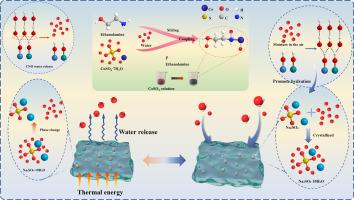Na₂SO₄·10H₂O水凝胶通过协同相变和蒸发冷却进行热管理
IF 13.2
1区 工程技术
Q1 ENGINEERING, CHEMICAL
引用次数: 0
摘要
随着集成电路功率密度的不断提高,对传统的无源散热提出了挑战,相变水凝胶等新型材料经常被需要。本文通过CoSO₄·7H₂O与乙醇胺的配位反应制备了Co-N/O配位结构的仿生出汗相变复合水凝胶。将水合盐相变材料Na₂SO₄·10H₂O包埋在聚丙烯酰胺基体中,并引入碳纳米管构建三维热传导通道。在相变过程中,Na₂SO₄·10H₂O吸收热量并释放水进行蒸发冷却。Co-N/O结构作为吸湿部位,在体系无活性时吸附环境水分,促进Na₂SO₄·10H₂O的水化再生,实现协同优化。该复合水凝胶的相变焓超过130 J·g−1。碳纳米管的加入使其导热系数提高了107 %,达到0.793 W·m−1·K−1。Co-N/O结构显著增强了其吸湿/解吸能力,在相对湿度为95% %时吸湿率为4.71 g·g−1,最大吸水率为2.7 g·g−1·h−1。在相对湿度为30 %时,在60 °C下,超过80 %的水在50 分钟内释放。在运行中,它降低了8.6 °C的加热板温度,并保持140 min的低温,为高密度电子设备的散热提供了高效和环保的解决方案。本文章由计算机程序翻译,如有差异,请以英文原文为准。

Na₂SO₄·10H₂O hydrogel for thermal management via synergistic phase change and evaporative cooling
With the increasing power density of integrated circuits challenging traditional passive heat dissipation, novel materials such as phase change hydrogel are often required. In this work, a biomimetic sweating phase change composite hydrogel is presented where a Co-N/O coordination structure is fabricated via the coordination reaction of CoSO₄·7H₂O and ethanolamine. The hydrated salt phase change material, Na₂SO₄·10H₂O, is embedded in a polyacrylamide matrix, and carbon nanotubes are introduced to construct a 3D thermal conduction pathway. During the phase change, Na₂SO₄·10H₂O absorbs heat and releases water for evaporative cooling. The Co-N/O structure, acting as a hygroscopic site, adsorbs ambient moisture when the system is inactive, promoting the hydration and regeneration of Na₂SO₄·10H₂O and enabling synergistic optimization. This composite hydrogel features a phase change enthalpy exceeding 130 J·g−1. The addition of carbon nanotubes boosts its thermal conductivity by 107 % to 0.793 W·m−1·K−1. The Co-N/O structure significantly enhances its moisture absorption/desorption capabilities, with a moisture absorption rate of 4.71 g·g−1 at 95 % relative humidity and a maximum water absorption rate of 2.7 g·g−1·h−1. At 30 % relative humidity, over 80 % of water is released within 50 min at 60 °C. In operation, it reduces the heating plate temperature by 8.6 °C and maintains a low temperature for 140 min, offering an efficient and eco - friendly solution for high - density electronic device heat dissipation.
求助全文
通过发布文献求助,成功后即可免费获取论文全文。
去求助
来源期刊

Chemical Engineering Journal
工程技术-工程:化工
CiteScore
21.70
自引率
9.30%
发文量
6781
审稿时长
2.4 months
期刊介绍:
The Chemical Engineering Journal is an international research journal that invites contributions of original and novel fundamental research. It aims to provide an international platform for presenting original fundamental research, interpretative reviews, and discussions on new developments in chemical engineering. The journal welcomes papers that describe novel theory and its practical application, as well as those that demonstrate the transfer of techniques from other disciplines. It also welcomes reports on carefully conducted experimental work that is soundly interpreted. The main focus of the journal is on original and rigorous research results that have broad significance. The Catalysis section within the Chemical Engineering Journal focuses specifically on Experimental and Theoretical studies in the fields of heterogeneous catalysis, molecular catalysis, and biocatalysis. These studies have industrial impact on various sectors such as chemicals, energy, materials, foods, healthcare, and environmental protection.
 求助内容:
求助内容: 应助结果提醒方式:
应助结果提醒方式:


